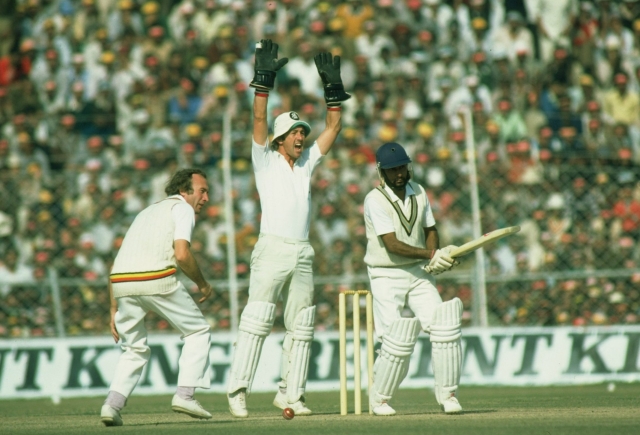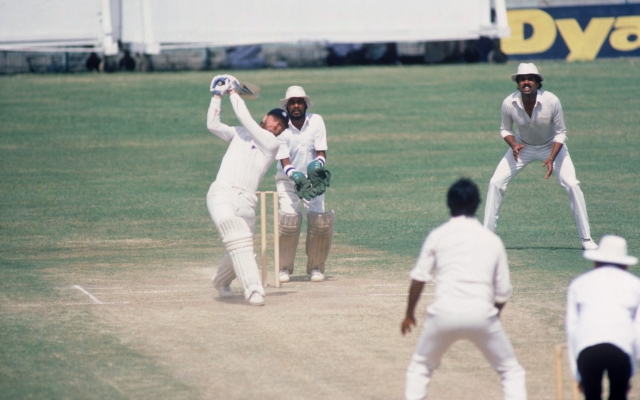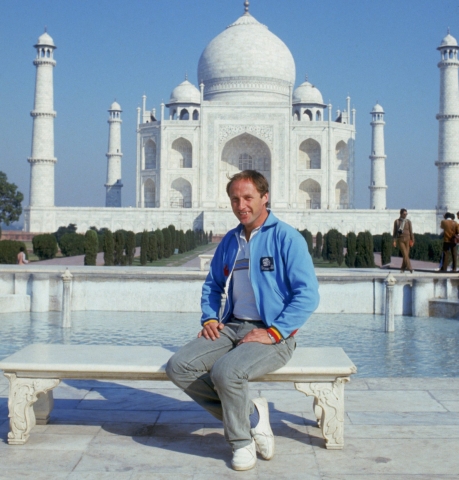 Keith Fletcher, Graham Gooch, Mike Gatting, Bob Willis, John Embury and others traveled to India in England in 1981. -82 Train Tour Photo: Getty Images/Adrian Murrell
Keith Fletcher, Graham Gooch, Mike Gatting, Bob Willis, John Embury and others traveled to India in England in 1981. -82 Train Tour Photo: Getty Images/Adrian Murrell
Nothing reflects how the Indian tour has changed more than the fact that England won't be spending all their time over the next seven weeks actually in India.
In the week between the second and third Tests, they will fly to the UAE to rest and recuperate, spend time with their families and, of course, play some golf. India has no shortage of beautiful resorts and golf courses, but the English clearly feel they need to go beyond what playing cricket in India can bring.
It's a far cry from using the downtime between Tests to play state matches in ramshackle old grounds or stay in hostels where players stuff old socks under the door to keep rats from infesting their rooms.
These stories of subcontinental wars are long and numerous. It doesn't take long for the veteran England international to break into them: Alan Knott refused to eat butter at the breakfast buffet because, on a previous tour, he thought droplets of water on its surface made him sick; John Lever ate banana toast throughout the tour; players living on the soup of the A Cup in Pakistan in 1987, and a trip to India in 1993 when a pilot strike forced the team to cross the country on long and grueling train journeys.
Airplane safety was another concern, and communications to home were spotty, slow and expensive. Security became a real threat during the 1984–85 tour of India when first Indira Gandhi and then British Deputy High Commissioner Percy Norris were assassinated the morning after he interacted with players in Mumbai. When the team bus passed the exact spot where he was killed the next day, with no security to keep an eye on them, some of the players were understandably nervous.
 Bob Taylor and captain Keith Fletcher ask for a wicket during the whirlwind 1981-82 tour of India. Photo: Adrian Murrell/Allsport
Bob Taylor and captain Keith Fletcher ask for a wicket during the whirlwind 1981-82 tour of India. Photo: Adrian Murrell/Allsport
But it's a world away from what the Buzzballers will experience. Yes, they play in some second-tier stadiums — notably Visakhapatnam, Ranchi and Rajkot — but these are all modern cities undergoing rapid change as India booms economically. The first test will take place in Hyderabad, the digital capital of India, and will boast plenty of Western elements, including an indoor snow dome. The fifth test in Dharamsala will provide cleaner air and perhaps a place to shelter if they need it by then.
The team behind the scenes at number 14 is despite Brendon McCullum cutting his coaching staff as he believes England's cricketers need to think for themselves more. Along with the three coaches, not including McCallum, there is a team doctor, head of security, tour manager, physiotherapist, massage therapist, analyst, strength and conditioning coach, digital editor, media manager and chef. In today's sports environment and for players with deep pockets, this makes sense because results are everything.
The chef's invitation has caused outrage on some social media in India, but this is not a slight to the hosts. This is to ensure that the players eat properly, getting some leftover spicy food, and as it turns out, they put together a team last year in Pakistan when there were food themed nights.
Marcus Stoinis from Australia was traveling with his personal chef in Pakistan. India at the World Cup; it's a sign of how much money players make these days compared to when Shane Warne lived on baked beans.
 Graham Fowler did the Century double in Madras, now Chennai, during the 1984–1985 tour. Photo: Adrian Murrell/Getty Images
Graham Fowler did the Century double in Madras, now Chennai, during the 1984–1985 tour. Photo: Adrian Murrell/Getty Images
India is familiar thanks to the IPL, so there shouldn't be the culture shock that there was for those in 1993, and in the absence of Harry Brooke, the top seven in the first Test have all played Test cricket in India before. The BCCI is interested in playing five Tests with England for financial and reputational reasons as it puts the series on par with the Ashes. But between 1984 and 2001, those three Tests (all batting) in 1993 were the only ones England played in India. By the end of this series, Joe Root will have played 15 Tests in India, more than any other England player except Derek Underwood.
India's 5G mobile network rollout is the second largest in the world and far ahead of the country, so connectivity is easy and inexpensive, and Uber taxis are ubiquitous in major cities. Even rickshaw pullers ride on Uber, which makes getting around easier as it removes the language barrier. Many of India's airports have been modernized and domestic travel is booming as the economy grows rapidly. India has doubled its number of airports over the past decade and expects passenger traffic to rise to 420 million from 192 million over the next four years. In England life is even simpler; they will travel on charter flights, rush through airports and undergo security checks.
The IPL billions have led to massive upgrades to the grounds and training facilities. Of the five test sites, all were built after 2003 and have since been renovated.
However, you wonder what the modern player is missing out on. Bob Taylor recalled meeting Mother Teresa in Calcutta last week, and Graham Fowler once told me of seeing the Red Fort, the Taj Mahal and sailing the Ganges while tour members of Pakistan in 2000 traveled through the Khyber Pass. “India stuck with me,” Fowler said. They made lifelong memories that the current generation will not get in their five-star hotels, golf courses and shopping malls (the only life outside they experienced at the World Cup). Security managers have to justify their work, and it is easier to refuse to leave the hotel than to take any risks.
 England player Vic Marks and several of his teammates set off on a dawn trip to Agra to see the Taj Mahal in 1985. Photo: Adrian Murrell/Getty Images
England player Vic Marks and several of his teammates set off on a dawn trip to Agra to see the Taj Mahal in 1985. Photo: Adrian Murrell/Getty Images
Politics and Indian nationalism probably don't bother Stokes too much, but they are much more intertwined with cricket than ever before. The politicization of BCCI by the ruling BJP includes family connections with the ruling party (BCCI Secretary Jay Shah is the son of the Home Minister), naming of the Narendra Modi stadium and even Ravi Jadeja's wife being an elected MP from the BJP. /p>
This will be most noticeable through one or two commentators waving flags. There is a real desire in some quarters to crush Baseball and show that he will not work on Indian pitches. Reading conditions are a problem that has plagued generations of tourists coming to India, who will again take advantage to the extreme. Sunil Gavaskar fired the first shot in the fake wars by writing a scathing column recently, saying he expected «whining and groaning» if England failed.
The crowds won't be nearly as big as the 1970s tours. and the 80s. In some places they will carry schoolchildren, and Test cricket will eclipse the IPL, which is another argument in favor of Baseball and England's attempts to make the format more interesting for today's fickle fans.
The umpire controversy has now subsided as the decision review system has removed suspicions of home bias, but it has also changed India's batting situation. Dropping the finger spinner was a reliable tactic before DRS, but now batsmen are given weight on the front foot, forcing them to bat instead, which truly produces better cricket, and that is why England chose Shoaib Bashir and Tom Hartley — two bowlers. they think it will challenge the front pad and stumps.
Bashir's visa delay was a small sign that politics could cause irritating problems, but the reception will remain warm and England are hugely popular in India. The 2024 tour will be very different from the tours of 1993, 1984-85 and those when Taylor shook Mother Teresa's hand and returned home to Staffordshire to raise money for cataract operations for the poor of Calcutta, but it will provide wonderful moments unique to India .
Listen to the Vogany and Tuffers podcast























































Свежие комментарии